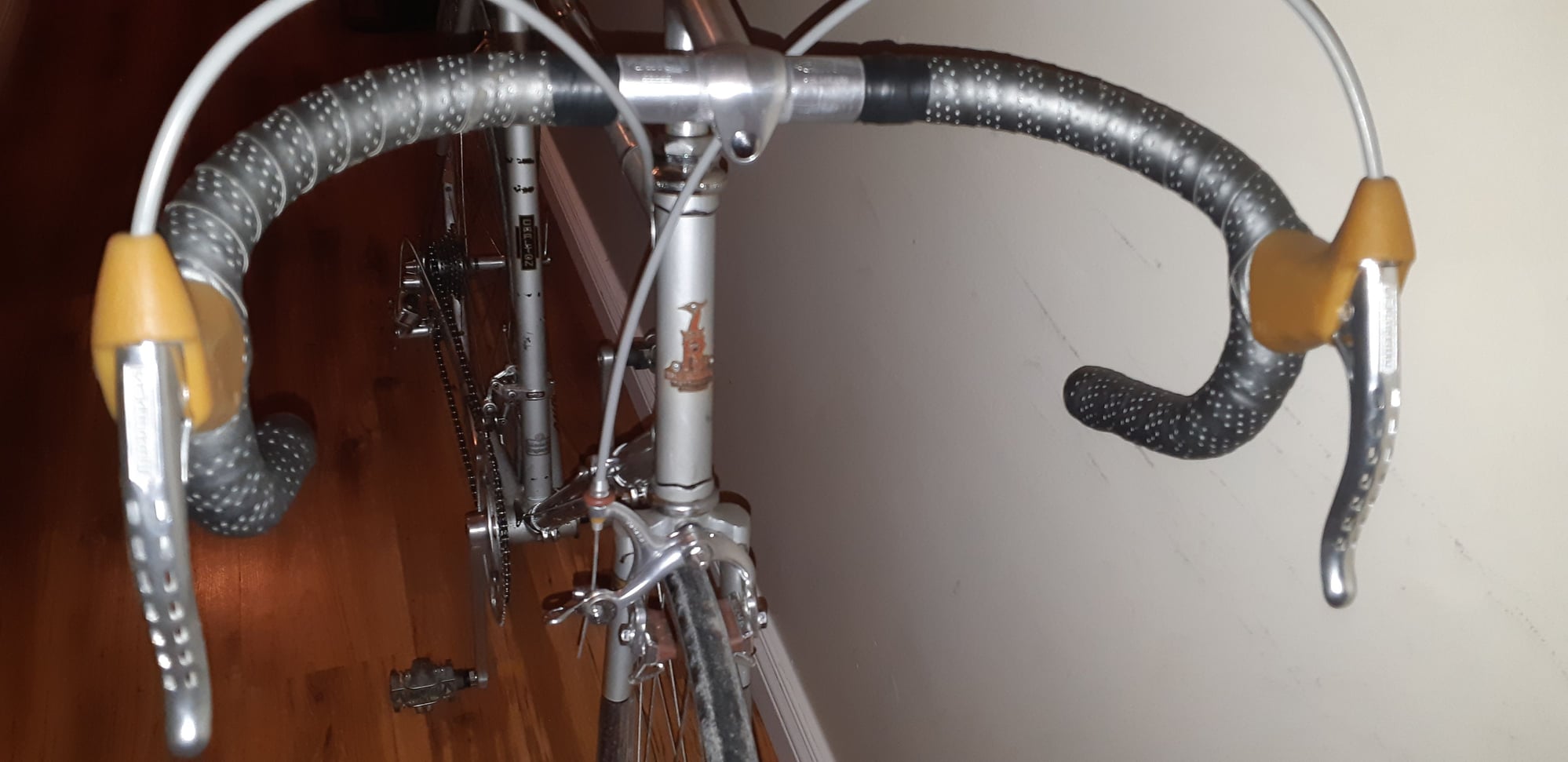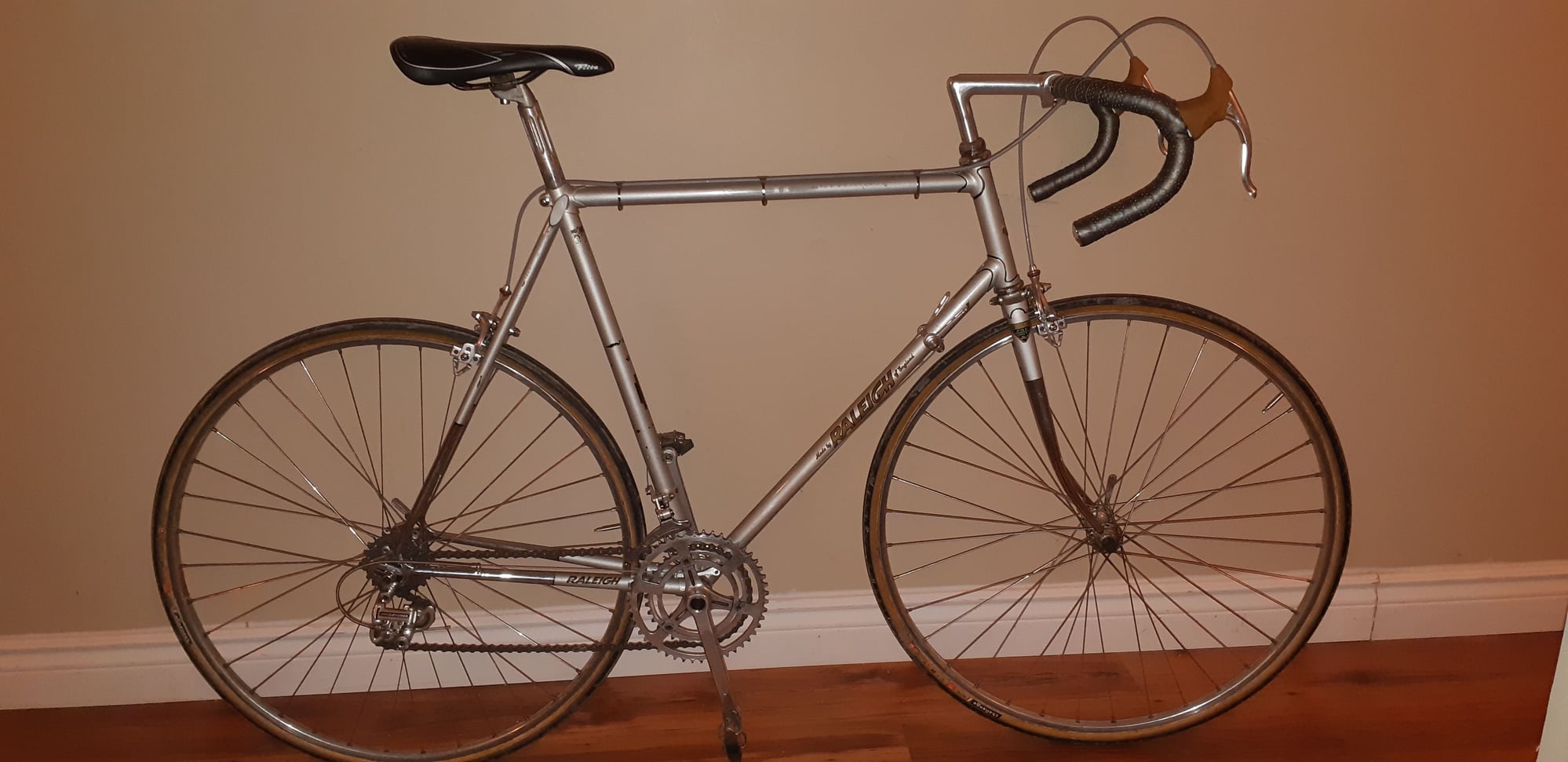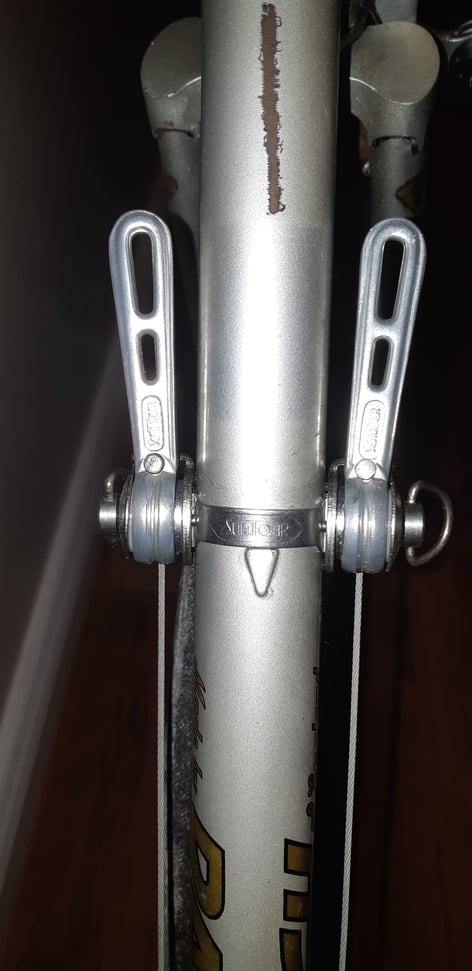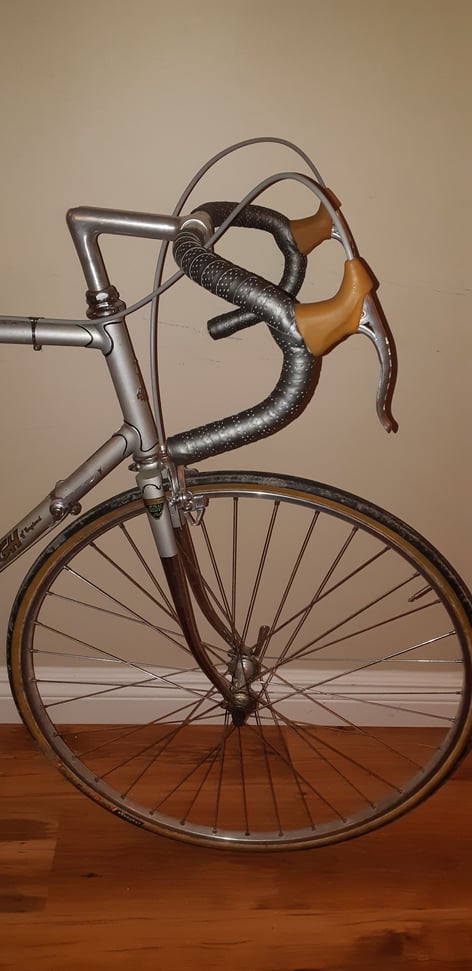French Crank - What to Do, what to Do?
#26
Full Member
Thread Starter
Join Date: Aug 2019
Location: North Eastern Ontario, Canada
Posts: 301
Bikes: 1980 Marinoni Special, 1987 Ciocc Microf. C40, 1978 Raleigh Competition GS, 1982 Colnago Super, 1972 Gitane Pro TdF, 1976 Belgian Diamant by Martelly, 1989 Trek 520, 1972 Dawes Galaxy 2014 Cervelo R5, 2020 Salsa Warbird, 2013 Giant Trance X1
Mentioned: 2 Post(s)
Tagged: 0 Thread(s)
Quoted: 91 Post(s)
Liked 61 Times
in
42 Posts
Edit - I have a 42t that I picked up for a great price in case my experiment below goes pear shaped.
I picked up the 36 t 6 pin eBay ring for kicks. If the bcd is the same, then theoretically 3 of the holes should be in the right spots (at 120° angles) and the other 3 holes will just not be used.
If the experiment is successful then booyah; I have contributed to furthering our knowledge. If not, I will have a 6 pin TA 36t ring for sale. I will post regardless, upon arrival and testing of said ring, of my triumphant experiment or my embarrassing failure.
I picked up the 36 t 6 pin eBay ring for kicks. If the bcd is the same, then theoretically 3 of the holes should be in the right spots (at 120° angles) and the other 3 holes will just not be used.
If the experiment is successful then booyah; I have contributed to furthering our knowledge. If not, I will have a 6 pin TA 36t ring for sale. I will post regardless, upon arrival and testing of said ring, of my triumphant experiment or my embarrassing failure.
Last edited by Dannyboy21; 11-01-20 at 11:00 AM. Reason: error 3
#27
Senior Member
"Steel ring teeth make sense; the smaller the ring the more sense they make. I suppose the best arrangement would be a U-channel ring of steel teeth with an inner aluminium ring and arms centrifugally cast into the ring and then machined and peened."
That is the intuitive response, but it may not actually be true. Long ago and far away, back when I used to work for a living as an engineer we avoided putting two hard or two soft materials together in situations where they would slide against each other without lubrication (lubrication being a big no-no in ultra-high vacuum field that I was working in). Much better if one piece was hard and the other soft. This could be as subtle as heat treating one for hardness and annealing the other but identical materials together would bind, gall and generally just tear each other up. You can see this for yourself if you take a stainless steel (not plated) nut and bolt, clean them carefully so there is no foreign material separating the threads then bolt them up tight. They will give you a hell of a time when you want to undo them. If you look at common items - engine crankshafts are super-hard, their bearing inserts are always soft metals. Bushings are bronze or even plastic, while the shafts that turn within them are steel. I'm not making this stuff up.
Things are slightly different in the bicycle drivetrain - a properly maintained cycle will have some lubrication on the chain/sprockets so the the base materials seldom actually contact each other and the correct term for bike chains is actually "roller chain" since the part that contacts the teeth is free to rotate allowing it roll down the tooth face rather than slide. But, in the case that the lubricating film is not adequate and/or the roller has too much friction to roll, the two metal parts will indeed slide against each other and now it is best if one of them is softer than the other. When you hear parts "squeak" that is them chattering unevenly as they attempt to slide one over the other.
I personally wish, from a wear standpoint, that the chain was the only sacrificial item since it is easier and less expensive to replace than worn chainrings, but my personal experience is that an aluminum chainring will have a life far longer than the chain that runs over it providing that the things are kept clean and the chain is discarded before it has stretched excessively.
That is the intuitive response, but it may not actually be true. Long ago and far away, back when I used to work for a living as an engineer we avoided putting two hard or two soft materials together in situations where they would slide against each other without lubrication (lubrication being a big no-no in ultra-high vacuum field that I was working in). Much better if one piece was hard and the other soft. This could be as subtle as heat treating one for hardness and annealing the other but identical materials together would bind, gall and generally just tear each other up. You can see this for yourself if you take a stainless steel (not plated) nut and bolt, clean them carefully so there is no foreign material separating the threads then bolt them up tight. They will give you a hell of a time when you want to undo them. If you look at common items - engine crankshafts are super-hard, their bearing inserts are always soft metals. Bushings are bronze or even plastic, while the shafts that turn within them are steel. I'm not making this stuff up.
Things are slightly different in the bicycle drivetrain - a properly maintained cycle will have some lubrication on the chain/sprockets so the the base materials seldom actually contact each other and the correct term for bike chains is actually "roller chain" since the part that contacts the teeth is free to rotate allowing it roll down the tooth face rather than slide. But, in the case that the lubricating film is not adequate and/or the roller has too much friction to roll, the two metal parts will indeed slide against each other and now it is best if one of them is softer than the other. When you hear parts "squeak" that is them chattering unevenly as they attempt to slide one over the other.
I personally wish, from a wear standpoint, that the chain was the only sacrificial item since it is easier and less expensive to replace than worn chainrings, but my personal experience is that an aluminum chainring will have a life far longer than the chain that runs over it providing that the things are kept clean and the chain is discarded before it has stretched excessively.
#28
Used to be Conspiratemus
Join Date: Jan 2009
Location: Hamilton ON Canada
Posts: 1,512
Mentioned: 4 Post(s)
Tagged: 0 Thread(s)
Quoted: 297 Post(s)
Liked 245 Times
in
163 Posts
^ Thank you so much for that.
Some years back I quoted the (now-late) Mike Barry of Mariposa Custom Cycles as saying that the introduction of "aluminium"-alloy chainrings during his racing career in the U.K. was a great advance because they lasted so much longer than steel. The pseudo-expertise of old-time bike gurus was sneered at by some of the Commentariat here. What did I know? -- I was only quoting an expert. But you would think if steel rings really did last longer, somebody would be making them at the high end and selling them at a premium -- harder to machine and all. Remember that steel parts aren't necessarily heavier than aluminum parts, since the strength-to-weight ratio is close to the same. The aluminum part has to be bigger, witness steel water-bottle cages and racks with their graceful thin lines, as long as stiffness isn't so crucial. Sometimes you want the part to be bigger without being heavier, and then of course the lighter metal wins.
And sometimes it's just better for the application, as you say.
Some years back I quoted the (now-late) Mike Barry of Mariposa Custom Cycles as saying that the introduction of "aluminium"-alloy chainrings during his racing career in the U.K. was a great advance because they lasted so much longer than steel. The pseudo-expertise of old-time bike gurus was sneered at by some of the Commentariat here. What did I know? -- I was only quoting an expert. But you would think if steel rings really did last longer, somebody would be making them at the high end and selling them at a premium -- harder to machine and all. Remember that steel parts aren't necessarily heavier than aluminum parts, since the strength-to-weight ratio is close to the same. The aluminum part has to be bigger, witness steel water-bottle cages and racks with their graceful thin lines, as long as stiffness isn't so crucial. Sometimes you want the part to be bigger without being heavier, and then of course the lighter metal wins.
And sometimes it's just better for the application, as you say.
#29
Senior Member
Join Date: Feb 2020
Posts: 2,820
Mentioned: 49 Post(s)
Tagged: 0 Thread(s)
Quoted: 1106 Post(s)
Likes: 0
Liked 1,328 Times
in
784 Posts
"Steel ring teeth make sense; the smaller the ring the more sense they make. I suppose the best arrangement would be a U-channel ring of steel teeth with an inner aluminium ring and arms centrifugally cast into the ring and then machined and peened."
That is the intuitive response, but it may not actually be true.
That is the intuitive response, but it may not actually be true.
#30
Used to be Conspiratemus
Join Date: Jan 2009
Location: Hamilton ON Canada
Posts: 1,512
Mentioned: 4 Post(s)
Tagged: 0 Thread(s)
Quoted: 297 Post(s)
Liked 245 Times
in
163 Posts
Edit - I have a 42t that I picked up for a great price in case my experiment below goes pear shaped.
I picked up the 36 t 6 pin eBay ring for kicks. If the bcd is the same, then theoretically 3 of the holes should be in the right spots (at 120° angles) and the other 3 holes will just not be used.
If the experiment is successful then booyah; I have contributed to furthering our knowledge. If not, I will have a 6 pin TA 36t ring for sale. I will post regardless, upon arrival and testing of said ring, of my triumphant experiment or my embarrassing failure.
I picked up the 36 t 6 pin eBay ring for kicks. If the bcd is the same, then theoretically 3 of the holes should be in the right spots (at 120° angles) and the other 3 holes will just not be used.
If the experiment is successful then booyah; I have contributed to furthering our knowledge. If not, I will have a 6 pin TA 36t ring for sale. I will post regardless, upon arrival and testing of said ring, of my triumphant experiment or my embarrassing failure.
Likes For conspiratemus1:
#31
Full Member
Thread Starter
Join Date: Aug 2019
Location: North Eastern Ontario, Canada
Posts: 301
Bikes: 1980 Marinoni Special, 1987 Ciocc Microf. C40, 1978 Raleigh Competition GS, 1982 Colnago Super, 1972 Gitane Pro TdF, 1976 Belgian Diamant by Martelly, 1989 Trek 520, 1972 Dawes Galaxy 2014 Cervelo R5, 2020 Salsa Warbird, 2013 Giant Trance X1
Mentioned: 2 Post(s)
Tagged: 0 Thread(s)
Quoted: 91 Post(s)
Liked 61 Times
in
42 Posts
To test-fit your experiment it is helpful to have the extractor at hand since getting the right spindle to fit the crank is an experiment in itself. You may find yourself needing to torque it on moderately to check for fit, then removing it to try another spindle. Once satisfied, you may not then need to remove the crank again, for years if you put a cartridge BB in. So if you don’t want to spring for a new Stein extractor, and if your mechanic won’t lend you his, I can lend you one of mine for few weeks while you get it sorted out, then you can mail it back to me. P.M. if interested. No charge.
#33
Junior Member
The rate of wear in a drivetrain depends not only on hardness of parts but the distribution of force. Chainrings wear much slower than cassettes because the pedaling force is distributed across many more gear teeth. A worn chain wears out a chainring more quickly because it rides up the teeth, which are tapered, so then drive the chain with a smaller contact area.
Such a thing exists! Surly stainless steel chainrings. Steels being what they are, this is still a soft metal to hard metal interface--only now the chain is the soft metal.
I believe some 1x12 systems use a hardened steel chain. Not sure what the rationale is.
I believe some 1x12 systems use a hardened steel chain. Not sure what the rationale is.
#34
Senior Member
Join Date: Feb 2020
Posts: 2,820
Mentioned: 49 Post(s)
Tagged: 0 Thread(s)
Quoted: 1106 Post(s)
Likes: 0
Liked 1,328 Times
in
784 Posts
The rate of wear in a drivetrain depends not only on hardness of parts but the distribution of force. Chainrings wear much slower than cassettes because the pedaling force is distributed across many more gear teeth. A worn chain wears out a chainring more quickly because it rides up the teeth, which are tapered, so then drive the chain with a smaller contact area.
#35
Used to be Conspiratemus
Join Date: Jan 2009
Location: Hamilton ON Canada
Posts: 1,512
Mentioned: 4 Post(s)
Tagged: 0 Thread(s)
Quoted: 297 Post(s)
Liked 245 Times
in
163 Posts
. . .
Such a thing exists! Surly stainless steel chainrings. Steels being what they are, this is still a soft metal to hard metal interface--only now the chain is the soft metal. . .
Such a thing exists! Surly stainless steel chainrings. Steels being what they are, this is still a soft metal to hard metal interface--only now the chain is the soft metal. . .
#36
Senior Member
The rate of wear in a drivetrain depends not only on hardness of parts but the distribution of force. Chainrings wear much slower than cassettes because the pedaling force is distributed across many more gear teeth. A worn chain wears out a chainring more quickly because it rides up the teeth, which are tapered, so then drive the chain with a smaller contact area.
Such a thing exists! Surly stainless steel chainrings. Steels being what they are, this is still a soft metal to hard metal interface--only now the chain is the soft metal.
I believe some 1x12 systems use a hardened steel chain. Not sure what the rationale is.
Such a thing exists! Surly stainless steel chainrings. Steels being what they are, this is still a soft metal to hard metal interface--only now the chain is the soft metal.
I believe some 1x12 systems use a hardened steel chain. Not sure what the rationale is.
#37
Senior Member
Join Date: Feb 2020
Posts: 2,820
Mentioned: 49 Post(s)
Tagged: 0 Thread(s)
Quoted: 1106 Post(s)
Likes: 0
Liked 1,328 Times
in
784 Posts
Such a thing exists! Surly stainless steel chainrings. Steels being what they are, this is still a soft metal to hard metal interface--only now the chain is the soft metal.
#38
Full Member
Thread Starter
Join Date: Aug 2019
Location: North Eastern Ontario, Canada
Posts: 301
Bikes: 1980 Marinoni Special, 1987 Ciocc Microf. C40, 1978 Raleigh Competition GS, 1982 Colnago Super, 1972 Gitane Pro TdF, 1976 Belgian Diamant by Martelly, 1989 Trek 520, 1972 Dawes Galaxy 2014 Cervelo R5, 2020 Salsa Warbird, 2013 Giant Trance X1
Mentioned: 2 Post(s)
Tagged: 0 Thread(s)
Quoted: 91 Post(s)
Liked 61 Times
in
42 Posts


So the 36t ring fits on the crank. Not an ideal fit and I had to put the crank bolts on backward (for now) as the small ring holes were not big enough for the female "nut". I may drill them out if after test riding the 36t ring is not too flexy and the shifts are good. More to follow.
#39
Full Member
Thread Starter
Join Date: Aug 2019
Location: North Eastern Ontario, Canada
Posts: 301
Bikes: 1980 Marinoni Special, 1987 Ciocc Microf. C40, 1978 Raleigh Competition GS, 1982 Colnago Super, 1972 Gitane Pro TdF, 1976 Belgian Diamant by Martelly, 1989 Trek 520, 1972 Dawes Galaxy 2014 Cervelo R5, 2020 Salsa Warbird, 2013 Giant Trance X1
Mentioned: 2 Post(s)
Tagged: 0 Thread(s)
Quoted: 91 Post(s)
Liked 61 Times
in
42 Posts
Resurrecting my own thread. I got ahold of some NOS and mint Suntour Superbe Pro bits and decided to build up this 78 Competition GS frameset. I put the TA crankset on it with the 36T, 6 hole "Mickey moused" on to the 3 bolt crank. I had to reverse the female and male bolts to make it work as the bolt holes on the 36 tooth are smaller. But aftern3 rides I can say the crankset has worked very well and the Suntour stuff, well, let's just say nobody has to do any convincing with me about the merits of Superbe.












Last edited by Dannyboy21; 04-13-21 at 08:12 PM. Reason: a
#40
vintage motor
Join Date: Sep 2008
Location: Tepic, Nayarit, Mexico
Posts: 1,595
Bikes: 48 Automoto, 49 Stallard, 50 Rotrax, 62 Jack Taylor, 67 Atala, 68 Lejeune, 72-74-75 Motobecanes, 73 RIH, 71 Zieleman, 74 Raleigh, 78 Windsor, 83 Messina (Villata), 84 Brazzo (Losa), 85 Davidson, 90 Diamondback, 92 Kestrel
Mentioned: 6 Post(s)
Tagged: 0 Thread(s)
Quoted: 164 Post(s)
Likes: 0
Liked 102 Times
in
79 Posts
Beautiful bike! I'm glad the chainring worked out. 36t is a nice ring size, low enough to give you a good climbing gear, high enough to still be useable on roads.







